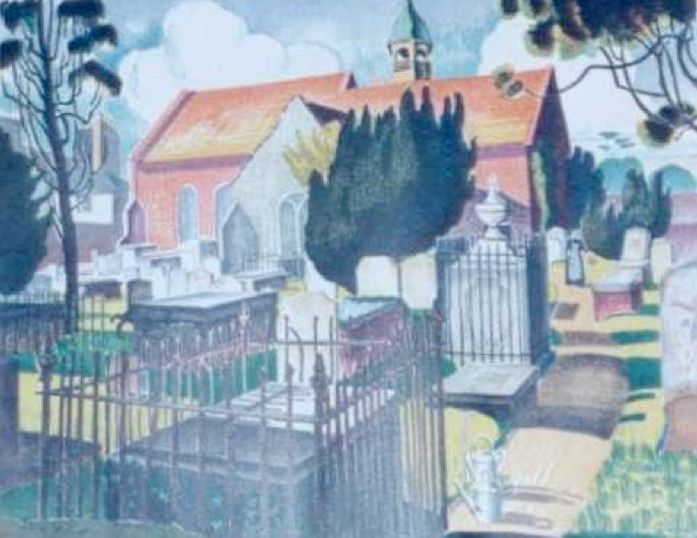History of St Peter's
|
The earliest record of Petersham is in 666 in the context of an endowment by Frithwald, Viceroy of Surrey, of all the chapels and lands held by the church at Kingston, to the Benedictine Abbey of St. Peter in Chertsey. A cell of monks from the Abbey lived in Piterichesham farming the land and river for the Abbey, and some site for worship existed –possibly a large Saxon cross in the open, with an adjacent stone altar.
The Domesday Survey of 1086 refers to the church which had been restored, and records the harvests produced by the monks. This would have been a stone Saxon chapel comparable to St.Mary’s chapel in Kingston. The oldest visible portion of the church today is the north wall of the chancel containing a bricked up Norman window. The church is next recorded in the early 12th century as having been transferred to the Merton Priory as part of the Kingston advowson. In 1505 the body of the church was rebuilt to include very small transepts on either side of the aisle, said to have contained Tudor box pews. At this time the wooden spire was rebuilt with brick, and the cupola may have been added. In 1549 Edward V1’s Commissioners confiscated the three bells which were later replaced by the present bell which dates from 1620.
The lower part of the present tower probably dates from 1505 and in the wooden belfry there is a bell which bears the inscription "Bryan Eldridge made mee" and the date "1620", when it was cast at Chertsey. The north and south transepts were added between 1704 – 1714 when Georgian box pews were installed. The Musicians gallery and north gallery were in place well before 1760 when further changes were made. The earliest mention of a pre-existing vestry room is in 1715 when the floor was raised and a small fireplace installed. |
The font dates from 1740, the pulpit from 1796, the Reading Desk and Clerk’s Desk are earlier and thought to have formed part of an original three decker pulpit and desks. In 1746 the tower room was converted into a parlour pew, and in 1767 repairs to the bell wheel and cupola were carried out.
The south transept was enlarged in 1840 at which time the central open pews known as the “Agricultural benches” were installed as were the choir and organ galleries after which the organ was moved from the tower room. A “Speechley” organ was purchased in 1914 which was replaced by a St. Martin organ in 2007. During 1838 –1853 a barrel organ had been in use. The Royal Arms above the chancel arch are those of George 111, the adjacent shields represent the arms of the See of Canterbury, the Diocese of Rochester, and the crossed keys attribution of St. Peter. The arms on the east wall of the north transept are those of the Gordon Forbes family. |
17th & 18th Century marriages
|
Mystery surrounds the supposed marriage at Petersham in 1664 of Prince Rupert of the Rhine, cousin of Charles 11. His supposed wife was Lady Francesca Bard, mother of his son Dudley Bard who was born about 1666. A document exists which seems to be their marriage certificate, signed by the then priest at Petersham, and Lady Francesca often claimed that they had been married. Unfortunately the relevant page in the Marriage Register was a very long time ago removed so the truth may never be known.
A marriage with royal connections which certainly took place was that between the future Earl of Strathmore and Nina Cavendish-Bentinck of Forbes House, Ham Common on the 16th July 1881. The youngest daughter of this marriage married the Duke of York in 1923 and became Queen in 1936 when he succeeded to the throne as George V1. |
19th Century
|
In 1874 the chancel was completely refurbished under the direction of John Gilbert Scott (son of the ecclesiastical architect Sir Gilbert Scott) whose residence was the Manor House, Ham and who had, the previous year, proposed a plan for the structural improvement of the chancel but the parishioners had turned it down.
A chancel screen was erected in 1899, but was removed in 1972 along with two box pews that obscured the altar. The font dates from 1740; the pulpit was made locally, by carpenter John Long, in 1796 and retains the original candle holders. Against the north wall of the chancel is the Cole monument recumbent effigies in Elizabethan dress. Beneath the Chancel step lies the Murray family vault (later the Tollemache family, owners of Ham House from 1626 until 1948). The Royal Arms under the chancel arch are of George III from1810. The adjacent shields, of local work, were placed there on 1898 and represent, from left to right, the keys of St. Peter, the arms of the diocese of Canterbury and those of the diocese of Rochester. |




